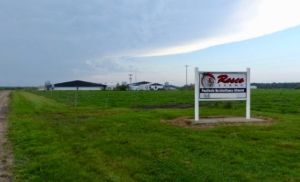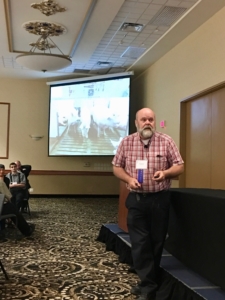National Sow Housing Conversion Project Coordinator Doug Richards, with the Prairie Swine Centre, said the importance of advanced planning is the key lesson learned from producers who have made the conversion from stall housing to group housing of gestating sows.
conversion from stall housing to group housing of gestating sows.
In response to requirements for the Canadian pork industry to move to group housing of gestating sows by 2024 Swine Innovation Porc is spearheading a project to which pork producers are allowing their sow barn conversions to be tracked and documented to provide information to help other producers make the change.
Richards said one of the main lessons learned so far, the value of advanced planning.
“This is a significant investment both in the producers’ time and in facilities and staff,” he said. “Consult and get as much information as you can before you do your conversion because there is going to be a learning curve. If you’ve got barn staff or other people involved in the operation get them involved right at first, so it isn’t one day we’re doing this because it is a huge change.
If used to working with animals in your gestation rooms in the stalls, and now you walk into a group of 50 or 100 or maybe 300 sows, the husbandry skills are a little bit different because now you have to work with the animals a little bit differently.”
 Richards said producers on the program now while not at a 100 per cent yet this is the way to go, but none of them have stated that they would do anything different. It does take a different mindset and those producers that have done it, the staff have enjoyed the conversion and a different atmosphere,” he said. “The animals react differently to things, but overall I think it’s been a very positive influence on the producers and the animals.
Richards said producers on the program now while not at a 100 per cent yet this is the way to go, but none of them have stated that they would do anything different. It does take a different mindset and those producers that have done it, the staff have enjoyed the conversion and a different atmosphere,” he said. “The animals react differently to things, but overall I think it’s been a very positive influence on the producers and the animals.
Richards said 20 years ago we didn’t have the science we have now, and we’ve got more technology today. In his tour across Canada looking at different barns, Richards visited barns all the way from New Brunswick to Alberta. “We’ve seen a barn that’s had it since 2004, and we’ve seen barns that are just starting up now, but all the barns we’ve seen have been successful doing what they’re doing. It was well planned out, and I think everybody’s happy with the decisions,” he said. “Well, a lot of them are just saying we’re gonna reduce the stalls that we have, put the sows in a free housing unit. And we will work with the system. And the sows, it’s just an acquired environment; the people enjoy working with it. And we haven’t had it long enough to see numbers, but production numbers won’t I don’t think, decrease. If anything, you know, it’s going to be the same or maybe better. It’s just a nicer environment for everybody to work in, and that’s something we have to take into account.” Richards said they’re finding if a producer leaves the sows in a group housing barn and give them a chance they will group out.
“We’ve have producers that wean every week, and those girls stay in their parody grouping. And they go in and, I mean, we can’t say there’s not aggression, but once we get over the initial phase, once the sows get in the routine and after second, third parody, they’ll group out, and they’ll just lie with their group,” he said. “And that group will go all around the barn if it’s a dynamic where if it’s static it doesn’t matter as much, but active, the girls actually will move around in their groups. And it’s worked well, I think, for producers to have.” Richards said in Ontario, they put the system in without training the sows and it was much tougher than thought because of poor setup.
“But once they’re trained properly, instead of forcing the animal through the experience, then every time they look at the feeder it’s a bad experience,” he said. “Where if trained properly, then the second, third and fourth time it’s a place to get fed, and it doesn’t matter.”
Richards said looking back; he wishes they’d had these electronic sow feeders back in the ‘80’s when he started in the hog business.
“We had some electronic feeding way back when, but we didn’t have the technology or software to run it, so a lot of electronic sow feeders ended up in the manure pile out back behind the barn. And so, it got a bad rap for a couple years, well, for a decade or two. Now it’s come back, we’ve got the technology, we understand what we’re doing, we know a lot more about the animal physiology of how the animals react,” he said. •
— By Harry Siemens




